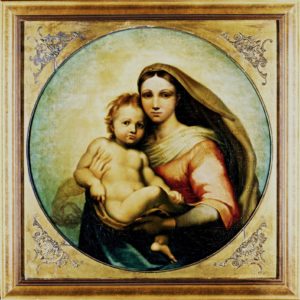Some months ago, I wrote about how a pair of British scientists used a facial recognition AI program to positively attribute a Madonna and Child painting to the Italian Renaissance master Raphael Sanzio. While this gained an incredible amount of attention in the press, very few people seemed to understand how misleading and flawed this claim was. And now, more people have added to the debate over the authorship of this painting.
The Madonna and Child painting, also known as the De Brécy Tondo, is considered by most art historians to be a later copy of a verified Raphael painting known as the Sistine Madonna, now kept at the Gamäldegalerie Alte Meister in Dresden, Germany. The only legitimate debate regarding the painting is when exactly it was created. Some claim it’s a nineteenth-century Victorian reproduction, while some chemical tests indicate it may have been made as early as the sixteenth century. For decades, the work’s previous owners, including the current one, Timothy Benoy, have pushed for its recognition as a legitimate Raphael. The facial recognition analysis done by Dr. Christopher Brooke and Dr. Hassan Ugail from the University of Nottingham and the University of Bradford, respectively, undoubtedly added some legitimacy to these claims among the general public. Then, there was the painting’s exhibition at Cartwright Hall Art Gallery in Bradford, where people could see this alleged Raphael up close.
However, facial recognition analysis only verified that the Madonna in the De Brécy Tondo and the Madonna in the Sistine Madonna were 97% similar. This does not mean that the same artist created the two paintings. That is simply an extrapolation that requires several leaps in logic to make. The fact that the faces are almost identical does not mean the same hand created them, nor does it debunk the claim that the Tondo is a later copy. Besides, it wouldn’t be much of a copy if it didn’t try to look exactly like the original. But now, even other AI experts are weighing in on the skeptics’ side. Carina Popovici is part of the Swiss AI company Art Recognition and has been involved in other cases of AI art attribution. Most notably, in one case I’ve written about, Art Recognition analyzed the Samson & Delilah painting by Peter Paul Rubens kept at the National Gallery in London. Art Recognition’s AI software is very different from just facial recognition. It uses a convolutional neural network, dividing the canvas into a grid and analyzing each cell for brushstroke patterns and color. The program compared this data to a control group of verified Rubens paintings and concluded that the National Gallery Samson & Delilah is likely not a genuine Reubens painting. Using her software, Popovici found that there is an 85% chance that the De Brécy Tondo is not, in fact, by Raphael.
This latest development only shows that, like in any academic field, one study does not make a consensus. Art historians and conservators agree that the De Brécy Tondo is not by Raphael Sanzio but rather a copy of his Sistine Madonna. A single AI program’s results will not drastically change anything, especially if a different AI program can easily contradict them. Popovici’s studies show the need for repeated, replicable results to confirm a hypothesis, part of the scientific method governing the physical and social sciences. Artificial intelligence can be a powerful tool in uncovering new information about paintings and other artworks. However, it is often the most effective if used in tandem with studies by experts in the field.

